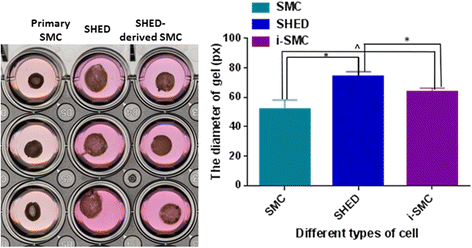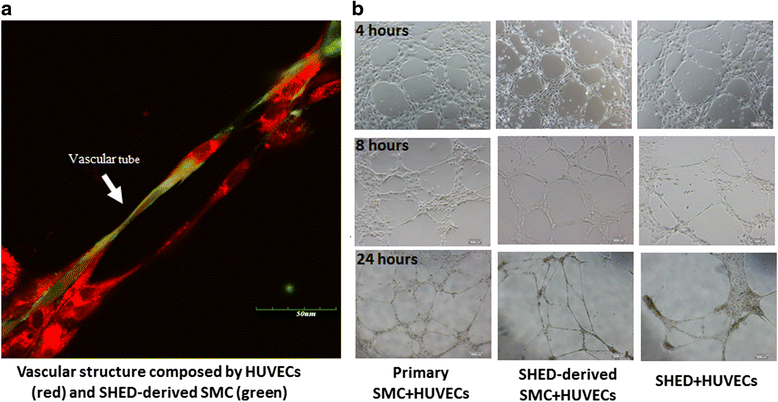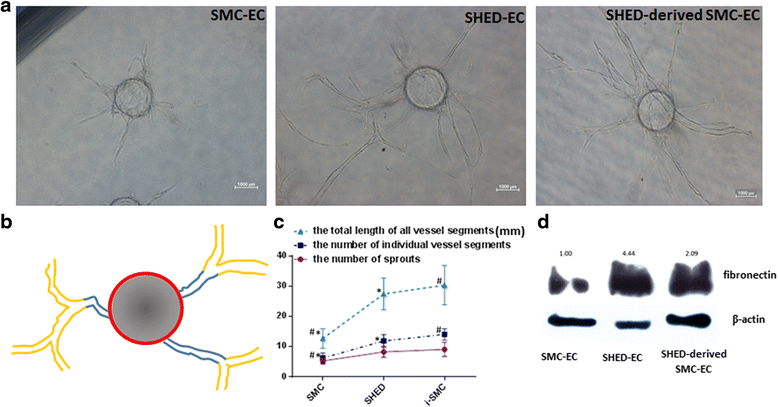TGF-β1-induced differentiation of SHED into functional smooth muscle cells
- PMID: 28114966
- PMCID: PMC5260045
- DOI: 10.1186/s13287-016-0459-0
TGF-β1-induced differentiation of SHED into functional smooth muscle cells
Abstract
Background: Adequate vascularization is crucial for supplying nutrition and discharging metabolic waste in freshly transplanted tissue-engineered constructs. Obtaining the appropriate building blocks for vascular tissue engineering (i.e. endothelial and mural cells) is a challenging task for tissue neovascularization. Hence, we investigated whether stem cells from human exfoliated deciduous teeth (SHED) could be induced to differentiate into functional vascular smooth muscle cells (vSMCs).
Methods: We utilized two cytokines of the TGF-β family, transforming growth factor beta 1 (TGF-β1) and bone morphogenetic protein 4 (BMP4), to induce SHED differentiation into SMCs. Quantitative real-time polymerase chain reaction (RT-qPCR) was used to assess mRNA expression, and protein expression was analyzed using flow cytometry, western blot and immunostaining. Additionally, to examine whether these SHED-derived SMCs possess the same function as primary SMCs, in vitro Matrigel angiogenesis assay, fibrin gel bead assay, and functional contraction study were used here.
Results: By analyzing the expression of specific markers of SMCs (α-SMA, SM22α, Calponin, and SM-MHC), we confirmed that TGF-β1, and not BMP4, could induce SHED differentiation into SMCs. The differentiation efficiency was relatively high (α-SMA+ 86.1%, SM22α+ 93.9%, Calponin+ 56.8%, and SM-MHC+ 88.2%) as assessed by flow cytometry. In vitro Matrigel angiogenesis assay showed that the vascular structures generated by SHED-derived SMCs and human umbilical vein endothelial cells (HUVECs) were comparable to primary SMCs and HUVECs in terms of vessel stability. Fibrin gel bead assay showed that SHED-derived SMCs had a stronger capacity for promoting vessel formation compared with primary SMCs. Further analyses of protein expression in fibrin gel showed that cultures containing SHED-derived SMCs exhibited higher expression levels of Fibronectin than the primary SMCs group. Additionally, it was also confirmed that SHED-derived SMCs exhibited functional contractility. When SB-431542, a specific inhibitor of ALK5 was administered, TGF-β1 stimulation could not induce SHED into SMCs, indicating that the differentiation of SHED into SMCs is somehow related to the TGF-β1-ALK5 signaling pathway.
Conclusions: SHED could be successfully induced into functional SMCs for vascular tissue engineering, and this course could be regulated through the ALK5 signaling pathway. Hence, SHED appear to be a promising candidate cell type for vascular tissue engineering.
Keywords: Angiogenesis; Dental pulp stem cells; Smooth muscle cells; Stemness; Tissue engineering.
Figures





Similar articles
-
Differentiation of adipose-derived stem cells into contractile smooth muscle cells induced by transforming growth factor-beta1 and bone morphogenetic protein-4.Tissue Eng Part A. 2010 Apr;16(4):1201-13. doi: 10.1089/ten.TEA.2009.0303. Tissue Eng Part A. 2010. PMID: 19895205
-
Human hair follicle stem cell differentiation into contractile smooth muscle cells is induced by transforming growth factor-β1 and platelet-derived growth factor BB.Mol Med Rep. 2013 Dec;8(6):1715-21. doi: 10.3892/mmr.2013.1707. Epub 2013 Sep 27. Mol Med Rep. 2013. PMID: 24084832
-
Direct contact with endothelial cells drives dental pulp stem cells toward smooth muscle cells differentiation via TGF-β1 secretion.Int Endod J. 2023 Sep;56(9):1092-1107. doi: 10.1111/iej.13943. Epub 2023 Jun 20. Int Endod J. 2023. PMID: 37294792
-
Bone morphogenetic protein-7 modulates genes that maintain the vascular smooth muscle cell phenotype in culture.J Bone Joint Surg Am. 2001;83-A Suppl 1(Pt 1):S70-8. J Bone Joint Surg Am. 2001. PMID: 11263669 Review.
-
Roles of SM22α in cellular plasticity and vascular diseases.Cardiovasc Hematol Disord Drug Targets. 2012 Dec;12(2):119-25. doi: 10.2174/1871529x11202020119. Cardiovasc Hematol Disord Drug Targets. 2012. PMID: 23030444 Review.
Cited by
-
Indispensable Role of HIF-1α Signaling in Post-implantation Survival and Angio-/Vasculogenic Properties of SHED.Front Cell Dev Biol. 2021 Jul 23;9:655073. doi: 10.3389/fcell.2021.655073. eCollection 2021. Front Cell Dev Biol. 2021. PMID: 34368116 Free PMC article.
-
Oral cavity-derived stem cells and preclinical models of jaw-bone defects for bone tissue engineering.Stem Cell Res Ther. 2023 Mar 16;14(1):39. doi: 10.1186/s13287-023-03265-z. Stem Cell Res Ther. 2023. PMID: 36927449 Free PMC article. Review.
-
A roadmap for developing and engineering in vitro pulmonary fibrosis models.Biophys Rev (Melville). 2023 Apr 28;4(2):021302. doi: 10.1063/5.0134177. eCollection 2023 Jun. Biophys Rev (Melville). 2023. PMID: 38510343 Free PMC article. Review.
-
Stem Cells from Human Exfoliated Deciduous Teeth (SHEDs) and Dental Pulp Stem Cells (DPSCs) Display a Similar Profile with Pericytes.Stem Cells Int. 2021 Jul 24;2021:8859902. doi: 10.1155/2021/8859902. eCollection 2021. Stem Cells Int. 2021. PMID: 34349804 Free PMC article.
-
Human placenta and trophoblast development: key molecular mechanisms and model systems.Cell Mol Life Sci. 2019 Sep;76(18):3479-3496. doi: 10.1007/s00018-019-03104-6. Epub 2019 May 3. Cell Mol Life Sci. 2019. PMID: 31049600 Free PMC article. Review.
References
Publication types
MeSH terms
Substances
LinkOut - more resources
Full Text Sources
Other Literature Sources
Medical
Research Materials
Miscellaneous

